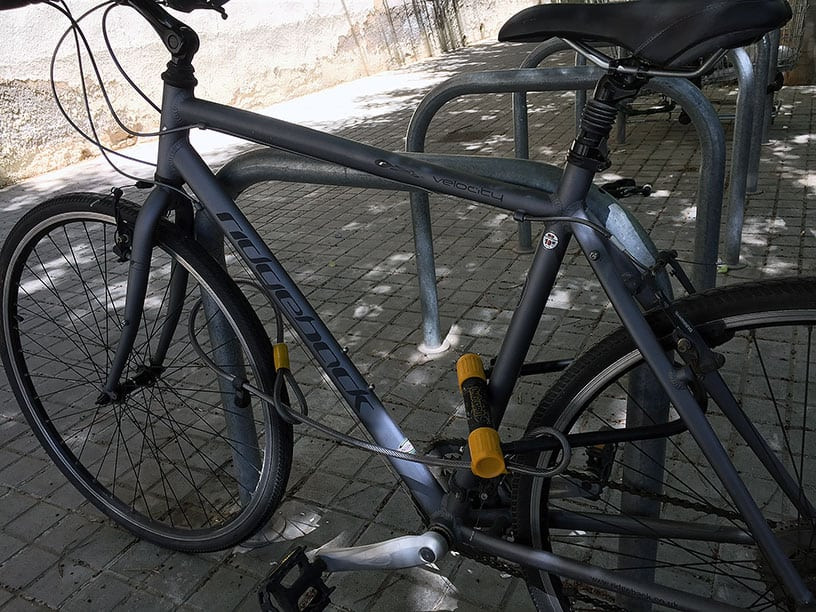A Bike Lock Cable might seem like the perfect solution to secure your bicycle. They appear affordable, lightweight, and incredibly convenient to carry and wrap around your bike when you need to lock it up.
However, there’s a harsh reality about bike lock cables: security is simply not their strong suit.
If there’s one undeniable fact in the world of bicycle security, it’s this: relying solely on a bike lock cable is practically inviting theft. It’s not a matter of if your bike will be stolen, but when. So, let’s make a promise right now:
Never, under any circumstances, depend on a cable lock as your primary bike security!
If you’re reading this because you’re considering buying a bike lock cable, I understand exactly where you’re coming from. I’ve been there myself.
I recall thinking, “My bike isn’t that fancy or expensive, thieves probably won’t bother with it.” And, “Surely, stores wouldn’t sell these bike lock cables if they weren’t reasonably secure, right?”
Based on this flawed logic, I purchased a cable lock for my brand-new bike. And guess what happened on the very first night I used it? My bike vanished!
The truth is, no bike is too “bad” to be stolen, and unfortunately, the retailers selling bike lock cables aren’t necessarily concerned about whether your bike remains yours.
Still not convinced? Perhaps you believe I’m just pushing you towards a more expensive lock. Let’s examine some real-world evidence through videos and crime statistics.
Witnessing Thieves Defeat Bike Lock Cables
Here are three videos capturing actual bike thefts where cable bike locks were used. It’s true that any lock can be defeated given the right tools and enough time. But observe just how effortlessly thieves operate when faced with these cable locks.
Some of these locks are so weak that a thief can simply use brute force to rip the bike free, no tools required.
[  Harvard Police Department Bike Theft Statistics
Harvard Police Department Bike Theft Statistics
In another instance, a thief uses a remarkably small pair of cable cutters to quickly snip through the bike lock cable. Fortunately, in this case, they were apprehended before they could take off with the bike.
[  U-lock with cable for secondary security
U-lock with cable for secondary security
Thicker bike lock cables might appear more robust, but they can still be cut through swiftly with slightly larger cable cutters or bolt cutters. The process remains quick and alarmingly easy.
Crime Data: The Stark Reality of Bike Lock Cables
My warnings aren’t just personal opinions; they’re supported by crime statistics. Numerous studies consistently show that using a bike lock cable significantly increases the likelihood of your bike being stolen. Consider this data:
Bike Thefts by Lock Type
Data from the Harvard Police Department in 2011 revealed a disturbing trend: nearly two-thirds of stolen bikes were secured with a cable bike lock. This clearly indicates that cable locks are disproportionately targeted and easily overcome by thieves.
[  Harvard Police Department Bike Theft Statistics
Harvard Police Department Bike Theft Statistics
The Inherent Weakness of Bike Lock Cables
What makes bike lock cables so vulnerable? They are constructed from multiple thin strands of steel encased in a plastic tube. This thinness is precisely what makes them light, flexible, and inexpensive – less metal equals lower cost.
However, these thin strands are also the fundamental flaw in their security. They can be effortlessly severed with cable cutters or bolt cutters. These tools essentially chew through the individual strands one by one, much like cutting through hair with scissors.
While thicker bike lock cables might give a false sense of security, the reality is that the increased thickness is often mostly due to a thicker plastic casing. The amount of steel inside often remains minimal.
Using a Bike Lock Cable as Secondary Security: A Risky Proposition
The crucial takeaway is to never rely on a bike lock cable as your primary security. Primary security refers to the lock that secures your bike frame to a fixed, immovable object in your surroundings.
Many cyclists choose to use a secondary lock, either as an additional layer of security for the frame, or more commonly, to secure the front wheel, seat, or both.
[  U-lock with cable for secondary security
U-lock with cable for secondary security
These secondary locks sometimes come in the form of thin cable lassos, often sold alongside a primary U-lock. These lassos are designed to be used in conjunction with another lock because they lack their own locking mechanism.
Personally, I’m not a fan of these cable lasso locks either. They can be snipped through rapidly with small, handheld cable cutters.
Furthermore, I find them inconvenient. They are often long and cumbersome, making them difficult to carry around, maneuver around your bike when locking up, and untangle when you’re ready to ride.
Having said that, they are undeniably better than no security at all for components like wheels and seats. If your bike has quick-release levers on the wheels or seat post, you absolutely need to protect them with something.
However, understand that a bike lock cable offers only minimal protection. A determined thief can easily steal your wheel or seat even with a cable lock in place.
Frankly, there are significantly more secure and user-friendly alternatives for protecting your wheels and seat. I strongly recommend exploring these options before considering a cable lock for this purpose.
In Conclusion: Ditch the Bike Lock Cable
The most vital message I want to convey is: stop using bike lock cables to secure your bicycle!
If everyone stopped using these ineffective locks, bicycle theft rates would likely plummet.
It’s understandable why they are appealing. They promise so much – lightness, ease of use and portability, and low cost. But they utterly fail at their core function: protecting your bike from theft.
While you won’t find another type of lock that perfectly replicates all the practical advantages of bike lock cables, you can find locks that offer some of those qualities while actually preventing theft.
Consider what aspects of cable locks are most important to you and what compromises you’re willing to make.
Then, use my simple three-step guide to find a bike lock that balances ease of use with robust protection against bike theft!
More Resources for Bike Security:
- Best U-locks for Bike Security
- How to Properly Lock Your Bike
- Win a Free Bike! (Survey)
 Win a Free Bike! Survey
Win a Free Bike! Survey
Participate in our survey for a chance to win a free bike!

